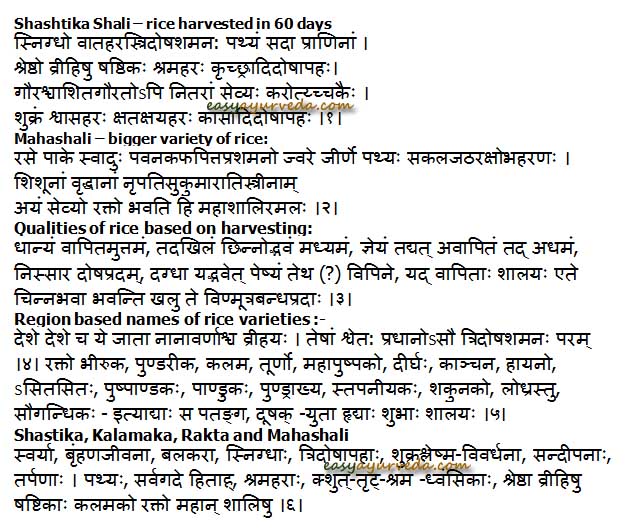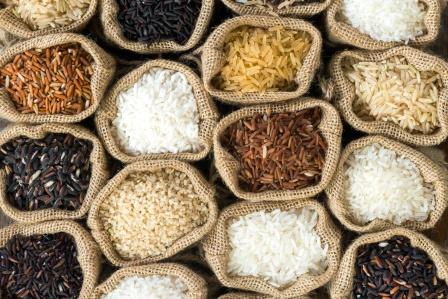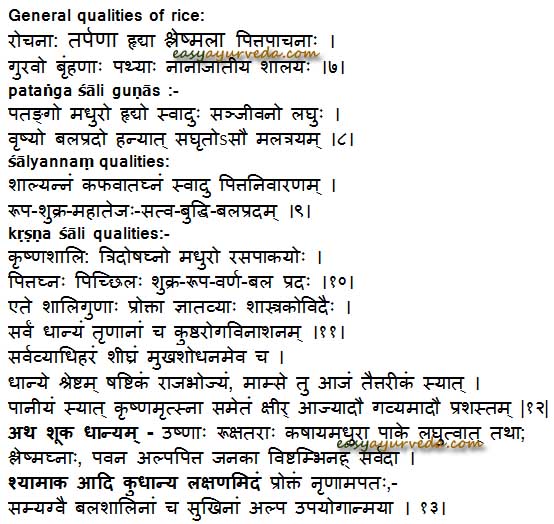Ayurveda Mahodadhi Dhanya Varga – Types Of Rice
By Prof. Vd Rangaprasad Bhat.
This is the first part of a chapter about grains and varieties of rice as explained in Ayurveda Mahodadhi, written by Sushena in 14th Century.

Table of Contents
Shashtika Shali
Shashtika Shali – Rice harvested in 60 days
Snigdha – unctuous, oily
Vatahara – useful in treating disorders of Vata Dosha imbalance such as neuralgia, paralysis, constipation, bloating, etc
Balances all the three Doshas
Pathya – condusive.
Shramahara – Relieves tiredness, fatigue
Improves Shukra Dhatu
Useful in
Shwasa – asthma and chronic respiratory disorders
Kshatakshaya – chest injury, pththis
Kasa – cough, cold
Krichra – dysuria

Varieties: white and black.
The white is most beneficial.
Of all the varieties of types of rices, Shashtika is superior. 1
Maha Shali Vrihi
महा शालि व्रीहि: –mahā śāli vrīhi:
Swadu – sweet taste, sweet taste conversion after digestion
Balances all the three Doshas
Useful in
Jeerna Jwara – end stage of fever
Jathara Kshobha- all diseases related to stomach
Ideal staple food for children, elders, women.
Improves blood. |2|
Read related: Poha – Flattened Rice: Qualities, Medicinal Uses, Recipes
Qualities of rice, based on the method of sowing and harvesting – indicating its usage for edibility :-
The grains which have been sown, grown and harvested are of first class quality.
The grains which are Chinnodbhava in nature (able to grow even if cut or harvested) are madhyamam (mediocre quality).
The grains that were avāpitaṃ (the sprouts of rice, planted as such as against the usual process of swing of seeds), when grown and harvested is adhama (with bad or degraded quality).
The extracted grains aggravate Doshas. So is the case with the dagdhā (scorched), peṣyaṃ(grounded), vipine(obtained from forest regions) grains.
Rice obtained by seed sowing definitely results in cinnabhavā dhānyam and when such grains are consumed they cause obstruction to the production and passage of faeces and urine. |3|
Which type of rice is best for daily use?
Rice varieties
Region based names of rice varieties :-
The colour of the grain differs from region to region based on the nature of soil and water irrigation methods).
Of those, the white variety of rice is supreme since it balances all the three Doshas. |4|
The other good varieties of rice are –
Rakto bhīruka,
puṇḍarīka (white variety of rice),
kalama (thick stemmed rice – sown in May and June and ripening in December or January),
tūrṇo (quickly maturing variety of rice),
mahāpuṣpako (with large flowers ?),
dīrghaḥ (long awned),),
kāñcana(golden husked),
hāyano (golden coloured),
asitasitaḥ (refers to the lemma and palea of the spikelet where in the at the stage of anthesis they are black in colour and at the time of maturity become white in colour),
puṣpāṇḍakaḥ (resembling ovary of flower),
pāṇḍukaḥ (yellowish),
puṇḍrākhya (whitish),
stapanīyakaḥ (?),
śakunako (curved),
lodhrastu (?),
saugandhikaḥ (fragrant)
pataṅga (resembling grasshopper or locust),
dūṣakyutā (?) |5|
Uses of rice varieties
Uses of ṣaṣṭika śāli, kalamaka śāli, rakta śāli & mahaśāli vrīhis:-
svaryā (beneficial to voice),
bṛṃhaṇa jīvanā (nourishing and enlivening),
balakarā (promotes strength),
snigdhāḥ (unctuous),
tridoṣāpahāḥ (negates tridoṣās),
śukraśleṣma-vivardhanā (increases śukra and śleṣma ),
sandīpanāḥ (augments jāṭharāgni),
tarpaṇāḥ (satiation)
pathyaḥ (wholesome),
sarvagade hitāh (wholesome in all diseases),
śramaharāḥ (removes exhaustion),
kśut-tṛṭ-śrama -dhvaṃsikāḥ (appeases hunger,thirst and tiredness) |6|

Shali general qualities
General qualities of śāli species:-
rocanā: (stomachic),
tarpanā (satiates),
hṛdyā (pleasant),
śleśmalā (increases Kapha Dosha)
pittapācanāḥ (supports Pitta and digestion)
guravo (heavy for digestion),
bṛṃhaṇāḥ (bulk promoting) and
pathyāḥ (wholesome). |7|
Patanga Shali
pataṅga śāli guṇās :- Resembling grasshopper or locust)
Rasa: sweetish (svAdu)
Guṇa: light for digesting (laghuḥ), hṛdyo
Vīrya: Sweet (madhura)
Vipāka: not mentioned
Karma: sañjīvano (enlivening/ life giver); vṛṣyo (promotes virility); balaprado(promotes strength).
Action on Doshās: When taken along with ghee control the tridosas (hanyāt saghṛto’sau malatrayam). |8|
Shali anna
śālyannaṃ qualities:
The śālyannaṃ (cooked śāli rice) appeases the kapha and vAta. Being sweetish in taste it reduces the pitta too. It bestows beauty (rūpa); śukra; (bright glow of aura) mahātejaḥ; mental strength(satva); intellect (buddhi). |9|
Krishna Shali
kṛṣṇa śāli qualities:- Black variety:
Rasa: madhura,
Guṇa: picchilaḥ,
Vīrya: not mentioned,
Vipāka: madhura,
Karma: It bestows shukra, beauty, skin colour and physical strength (śukra-rūpa-varṇa-bala pradaḥ),
Action on Doshās: It alleviates tridoṣās, more so the pitta. (tridoṣaghno; pittaghnaḥ) |10|
Thus ends the guṇas of śāli as said in the śāstrās.
Of all the cereals and grasses, Rice – shali is wholesome and useful in skin disorders. They are beneficial in almost all diseases and are quicker in clearing the obstruction inside the channels of the body.
Amongst the dhānyas – ṣaṣṭikaṃ is superior food( rājabhojyaṃ);
Among meat, goat meat is best
Amoung liquids, milk and ghee stored in mud pot made up of black mud is best. |11-12|
॥ Thus ends the (explanation) śāli vargāḥ ॥
Shuka Dhanya
śūka dhānyam
śyāmāka etc kudhānya (millets etc minor cereals) are lesser beneficial to the human system and are very rarely used as staple food.
Their qualities are –
Rasa: astringent and sweetish (kaṣāyamadhurā),
Guṇa: hot and dry (uṣṇāḥ rūkṣatarāḥ),
Vīrya: hot (uShNa),
Vipāka: astringent and sweetish( kaṣāyamadhurā),
Karma: Causes obstruction in the channels (viṣṭambhinah sarvadā)
Action on Doshās: (śleṣmaghnāḥ) (pavana alpapitta janakā).
Click to consult Vd. Rangaprasad Bhat










21 comments
Sridhar
Namaste. Very informative article with detailed explanation.
In the article, I see that millets is mentioned as less beneficial and not used as staple food. However, millets such as Ragi and Jowar is staple in many parts of India. So, this seems to be opposite of reality. Please give your inputs in this.
Thank you
Dr J V Hebbar MD(Ayu)Author
Hi, only the regular millets such as Ragi and Jowar are of good value. The minor millets, which have recently hit the market are mostly made of fiber and do not possess much nutrients.
rupeshc
Can we eat fruit and vegetables together
Most ayurvedic masters says do not eat fruit with other foods eat it separately .in ayurveda it is given anywhere that not eat fruit with other foods
Dr J V Hebbar MD(Ayu)Author
Fruits and vegetables can be taken together.
Miss Surabhi Saxena
Does rice increase weight?
Surabhi
Petchi Ram
Hi,
Which type of rice is easier to digest ? Raw rice or Parboiled rice ?
Also may i know which type of rice is used in the preparation of khitchari as stated in ayurvedic texts ?
Dr J V Hebbar MD(Ayu)Author
Raw rice – when used after cooking is easier to digest.
Raw rice is used for making kichari etc.
Alexander
Hello, sir! In my country we have WHITE rice, STEAMED rice, BROWN rice and RED unrefined rice (which is difficult to find, btw). So, is there analogues of these types of rice in the article? I just can’t find it (only general?). And which of them is better for everyday consuming? Thank you.
Dr J V Hebbar MD(Ayu)Author
Red variety of rice is best to use on a daily basis as per charak samhitha.
Sophie
Dr. Hebbar, most rice varieties are pre-boiled before being sold. Would a parboiled, red rice, be harmful especially for those prone diabetes?
Thanks for your wonderful website and guidance.
Dr J V Hebbar MD(Ayu)Author
Namaste. Perboiled rice is slightly heavy to digest than normal rice. Both are fine to take in diabetes.
sophie
Dr. Hebabr,
Can jowar and ragi be eaten everyday? Is it safe for the thyroid? I feel a heightened sense of well-being after eating ragi and would like to continue to do so.
Thanks so much!
Dr J V Hebbar MD(Ayu)Author
Jowar and ragi – both are used as staple food in India. Hence, both are very good to be used daily.
sweta gusain
Namaste. Thank you for the wonderful articles.
For a person with Kapha aggravation, rice would further aggravate it. But in south India it is a staple food. Do the local varieties of rice differ in their effect on Kapha dosha?
Dr J V Hebbar MD(Ayu)Author
The spices that we, south Indians use in rasam, sambhar etc. negates the Kapha dosha aggravation. For a healthy body, kapha should be well nourished with coolant rice.
sweta gusain
Thank you!
I understand that spices will negate the effect of rice.
Does this mean every grain can be consumed everyone, if supplemented by a dish that has opposite properties? There shouldn’t be restriction to a particular grain in case of any dosha aggravation? A heating grain can be consumed by a Pitta person if taken along with a cooling curry or sabzi??
Dr J V Hebbar MD(Ayu)Author
In case of a serious disease, we can carefully pick and choose the grains that are suitable for the person. Because, it will be the major part of the food, the choice of grain would also matter in a disease situation. For example, in obesity, barley is better than rice to keep Kapha under check.
In a healthy person however, the choice of grain does not matter much, as long the diet is wholesome and nutritious.
sweta gusain
If a Kapha-Pitta person (who has Kapha aggravation) eats the combination of Rice and Sambar/Rasam (with good amount of spices) to balance Kapha dosha, will it not vitiate the Pitta dosha in the body due to the spices? How should the person bring balance here while eating rice?
Dr J V Hebbar MD(Ayu)Author
In a kapha pitta person, with Kapha aggravation, rice and spicy sambar is a good combination.
The pitta might not be a point of worry here, as the disease is exclusively caused by Kapha and the person has Kapha dominant Prakriti.
The rice itself, being a coolant would nullify the possible Pitta aggravation by the spicy sambar.
Half a teaspoon of ghee can be added to it, if Pitta aggravation is the real concern.
sweta
Thank you so much. I am grateful for such wonderful replies of yours.
Prakash
I appreciate Dr Hebbar’s knowledge .But he seems to misguide since Rice is not suitable for people suffering from Kapha dosha.But in south India I see people eat rice even in aggravated kapha dosha condition.
Being a dr.you should support true knowledge not the eating habits of your culture